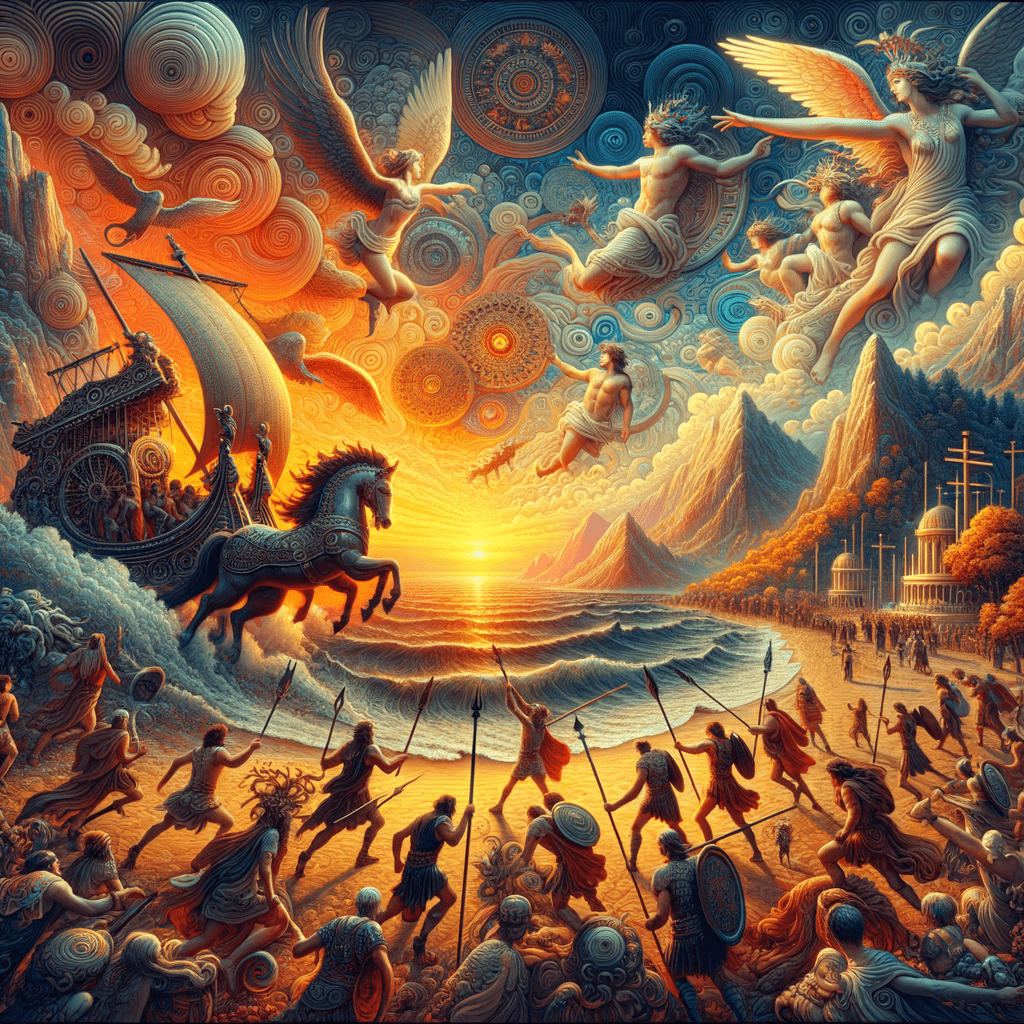The Great Epics of Antiquity: The Iliad, The Odyssey, and The Aeneid – History, Differences, and Influence on Western Culture
The three great epic works of ancient literature, the Iliad, the Odyssey, and the Aeneid, have fascinated readers and scholars for centuries. In this article, we will explore the history of each work, their differences, and the similarities that connect them. Discover how these masterpieces have influenced Western culture and continue to do so today.
- Story of the Iliad
- Story of the Odyssey
- History of the Aeneid
- Differences Between the Works
- Analogies between the works
- Conclusion
History of the Iliad
The Iliad is an epic poem attributed to the Greek poet Homer, composed in the 8th century BCE. This masterpiece of ancient literature recounts the events that occurred during the final year of the legendary Trojan War, focusing particularly on the character of the Greek hero Achilles.The work opens with a quarrel between Achilles, the greatest Greek warrior, and Agamemnon, the supreme commander of the Greek forces. The dispute arises over the slave Briseis, who is contested between the two, and leads Achilles to withdraw from combat, an event that has serious repercussions on the course of the war. Without his presence in battle, the Greeks suffer numerous defeats at the hands of the Trojans, led by the valiant prince Hector.The Iliad does not merely describe the actions and deeds of the warriors but also explores profound and universal themes such as honor, glory, fate, and mortality. Achilles, although a demigod, is tormented by existential dilemmas and the awareness of his own mortality. His anger and desire for revenge are recurring motifs in the narrative, culminating in his decision to return to battle to avenge the death of his friend Patroclus, killed by Hector.The poem concludes with the duel between Achilles and Hector, a moment of great tension and pathos. Achilles succeeds in killing Hector and, despite his anger, returns the enemy’s body to Priam, king of Troy and Hector’s father, who goes to the Greek camp to plead for the return of his deceased son. The narrative ends with the solemn funeral of Hector, a moment of great emotion that underscores the humanity and vulnerability of even the greatest heroes.The Trojan War, at the center of the Iliad, is sparked by the abduction of Helen, the beautiful wife of Menelaus, king of Sparta, by Paris, a Trojan prince. This act provokes the wrath of the Greeks, who unite under the leadership of Agamemnon to besiege Troy and bring Helen back home. However, the Iliad primarily focuses on the events and emotions that develop during the last year of the conflict, rather than the entire duration of the war.In addition to its compelling plot and complex characters, the Iliad offers a vivid portrait of ancient Greek society and culture. Through detailed descriptions of armor, weapons, religious ceremonies, and social interactions, the poem provides valuable insights into the life and values of the Greeks of that era. Moreover, the numerous gods who intervene in the narrative reflect the worldview of the ancient Greeks, in which the deities played an active role in human affairs.In summary, the Iliad is much more than a simple war story; it is a work that explores the human condition in all its complexity, offering reflections that remain relevant even for contemporary readers.
History of the Odyssey
The Odyssey, also attributed to Homer, is an epic poem that narrates the journey home of Odysseus (also known as Ulysses) after the fall of Troy. Composed in the 8th century BC, this monumental work spans 24 books and describes the adventures and difficulties Odysseus faces in his attempt to return to his beloved Ithaca. This adventurous journey lasts ten years and takes place after the ten years of the Trojan War, making Odysseus’s return home a total of twenty years.
Among his most famous adventures are the encounter with the Cyclops Polyphemus, a one-eyed monster that Odysseus manages to deceive and blind in order to escape; the seduction of the sorceress Circe, who transforms Odysseus’s companions into pigs but then, thanks to Odysseus’s ingenuity, returns them to their human form and becomes a valuable ally; and the passage between Scylla and Charybdis, two sea monsters that pose a deadly threat to sailors.
The Odyssey explores universal themes such as ingenuity, perseverance, and the desire for home. Odysseus is often celebrated for his cunning and intelligence, traits that allow him to overcome the most insurmountable obstacles. The protagonist’s perseverance is equally central, as despite the countless difficulties and temptations he encounters along the way, Odysseus never loses sight of his goal to return to Ithaca and reunite with his family.
The poem offers a complex and fascinating portrait of the protagonist, who is at once an epic hero and a man with weaknesses and doubts. His ability to show human emotions, such as suffering, anger, and desire, makes Odysseus a deeply three-dimensional character resonant with readers of all ages.
Besides Odysseus’s personal adventures, The Odyssey also presents a series of episodes involving his family and his kingdom. Penelope, Odysseus’s faithful wife, is celebrated for her loyalty and intelligence, while Telemachus, Odysseus’s son, grows and matures throughout the poem, becoming a young man capable of confronting the suitors who threaten the kingdom of Ithaca.
The Odyssey is not just a tale of adventures but also a profound reflection on human nature, destiny, and the divine. The gods of Olympus play a significant role in the story, influencing the fate of Odysseus and other characters. Athena, in particular, is a protective goddess who helps Odysseus on many occasions, while Poseidon, the god of the sea, is hostile to him because of the blinding of his son Polyphemus.
In summary, The Odyssey is a literary work of extraordinary richness and complexity, which continues to be studied and admired for its thematic depth, vivid descriptions, and complex characters. It is a masterpiece of ancient epic that has influenced countless works of literature and art throughout the centuries.
History of the Aeneid
The Aeneid is an epic poem written by the Roman poet Publius Vergilius Maro, commonly known as Virgil, between 29 and 19 BC. This masterpiece of Latin literature tells the story of Aeneas, a Trojan hero who, after the fall of Troy, escapes the burning city and embarks on a long and dangerous journey to establish a new homeland in Italy. The work is composed of 12 books and is divided into two main parts: the first half narrates the escape from Troy and the journey to Italy, while the second half describes the war for the conquest of Latium, necessary to lay the foundations for the future greatness of Rome.
The Aeneid is considered not only a literary masterpiece but also a work of political propaganda. Virgil wrote it under the patronage of Emperor Augustus, and through the poem, he sought to legitimize Augustus’s power and celebrate the mythical origins of Rome. Aeneas, in fact, is presented as an ancestor of Romulus and Remus, the legendary founders of Rome, and thus as a precursor to Roman glory.
One of the central themes of the Aeneid is fate (fatum), which guides and compels Aeneas to undertake his mission. Despite the hardships and sufferings, Aeneas always remains faithful to his duty (pietas), another fundamental concept of the work. Aeneas’s pietas is directed towards the gods, his family, and his future homeland, manifesting in his continual personal sacrifice for the greater good.
The poem also tackles themes such as sacrifice and renunciation. Aeneas must leave behind his past, including his loved ones and Trojan roots, to embrace an uncertain but glorious future. This sense of sacrifice for a higher good resonates deeply in Roman culture, which immensely valued the concept of duty towards the state and the gods.
The Aeneid is also rich in symbolism and mythological allusions, reflecting the religious and cultural beliefs of the time. The narrative is filled with divine interventions, prophetic dreams, and visions that guide and support Aeneas on his journey.
In addition to its political and symbolic value, the Aeneid is appreciated for its complex structure and refined style. Virgil employs a variety of poetic techniques, including the use of dactylic hexameter, which gives the poem a musical and solemn quality. The vivid descriptions and well-developed characters make the work not only an important historical and political document but also a compelling read with great emotional depth.
In conclusion, Virgil’s Aeneid is a monumental work that has left an indelible mark on Western literature and culture. It celebrates the Roman virtues of duty, sacrifice, and piety while legitimizing Augustus’s power and glorifying the mythical origins of Rome. With its universal themes and stylistic mastery, the Aeneid continues to be studied and admired as one of the great masterpieces of world literature.
Differences Between the Works
Despite the similarities, the Iliad, the Odyssey, and the Aeneid present several significant differences:
- Main Characters: The Iliad focuses on Achilles, the Odyssey on Odysseus, and the Aeneid on Aeneas.
- Themes: The Iliad explores honor and glory in war, the Odyssey focuses on the journey and return home, while the Aeneid examines fate and the founding of a new homeland.
- Structure: The Iliad and the Odyssey each consist of 24 books, while the Aeneid consists of 12 books.
- Origin: The Iliad and the Odyssey are Greek works, while the Aeneid is a Latin work.
Similarities Among the Works
Despite the differences, the three works share several similarities:
- Epic: All three works are epic poems that narrate the deeds of legendary heroes.
- Mythology: The works are deeply rooted in Greek and Roman mythology.
- Universal Themes: Honor, glory, destiny, and sacrifice are common themes across all three works.
- Cultural Influence: The works have had an enormous influence on Western literature and culture.
Conclusion
In conclusion, the Iliad, the Odyssey, and the Aeneid are three masterpieces of ancient literature that continue to fascinate and inspire readers and scholars. Despite their differences, they share universal themes and a deep connection with mythology. Their influence on Western culture is undeniable, making them essential works for anyone who wants to understand the roots of our civilization.
For further insights, you can consult the following resources:




